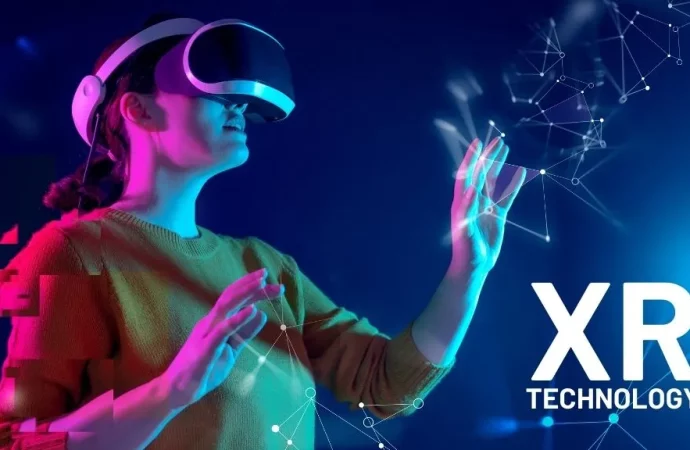Extended Reality (XR) encompasses a range of immersive technologies, including Virtual Reality (VR), Augmented Reality (AR), and Mixed Reality (MR), that have revolutionized the training landscape. The role of Extended Reality in immersive training experiences cannot be overstated. By creating realistic simulations and environments, XR allows trainees to engage in hands-on learning without the risks
Extended Reality (XR) encompasses a range of immersive technologies, including Virtual Reality (VR), Augmented Reality (AR), and Mixed Reality (MR), that have revolutionized the training landscape. The role of Extended Reality in immersive training experiences cannot be overstated. By creating realistic simulations and environments, XR allows trainees to engage in hands-on learning without the risks or costs associated with real-world training. This immersive nature of XR ensures that learners are more engaged, which translates to better understanding and retention of information. Moreover, the role of Extended Reality in enhancing learning retention rates is significant. Studies have shown that immersive learning environments can improve retention rates by up to 75%, as the interactive and engaging nature of XR helps to solidify the knowledge and skills being taught.
Benefits of Immersive Learning
One of the most compelling benefits of immersive learning is the enhanced engagement through the role of Extended Reality. Traditional training methods often struggle to maintain learner interest, but XR’s interactive and immersive experiences capture and hold attention far more effectively. This heightened engagement leads to a deeper understanding of the material. Additionally, improved retention rates with Extended Reality immersive experiences are a notable advantage. By providing a multi-sensory learning experience, XR helps learners to better internalize and recall information, which is crucial for effective training and skill development.
Technological Advancements in XR

Image by : Yandex
Technological advancements in XR have played a crucial role in creating immersive learning environments that are both realistic and interactive. The role of Extended Reality in immersive learning environments is evident as these technologies continue to evolve, offering more sophisticated simulations that closely mimic real-world scenarios. This realism is essential for effective training, as it allows learners to practice and refine their skills in a safe and controlled setting. Furthermore, the role of Extended Reality in skill refinement and assessment is invaluable. XR provides immediate feedback and allows for repeated practice, enabling learners to hone their skills and receive assessments that are more accurate and detailed than traditional methods.
XR in Corporate Training
Several case studies highlight the effective role of Extended Reality in immersive learning experiences within corporate training. For instance, companies like Walmart and Boeing have successfully implemented VR training programs to simulate real-world challenges and scenarios. These immersive experiences have not only improved employee performance but also increased engagement and satisfaction. Additionally, the role of Extended Reality in enhancing employee skill retention is evident in these case studies. Employees trained using XR technologies demonstrate higher retention rates of the skills and knowledge acquired, leading to better performance and reduced training costs over time.
Challenges and Limitations of XR
Despite its many benefits, there are challenges and limitations associated with the role of Extended Reality in training. One significant challenge is the high costs in implementing the role of Extended Reality. Developing and deploying XR training programs require substantial investment in hardware, software, and content creation, which can be prohibitive for many organizations. Additionally, there are technical limitations in current role of Extended Reality systems. Issues such as limited field of view, latency, and the need for high-performance computing resources can impact the effectiveness and accessibility of XR training solutions.
Future Trends in XR Training
Looking ahead, several future trends in XR training are poised to further enhance its effectiveness. One promising trend is the role of Extended Reality in personalized training experiences. By leveraging data and analytics, XR can offer tailored training programs that adapt to the individual needs and learning styles of each trainee, resulting in more effective and efficient learning. Another exciting development is the role of Extended Reality in enhancing remote collaboration. As remote work becomes more prevalent, XR technologies can facilitate virtual collaboration and training sessions, enabling teams to work together seamlessly regardless of their physical locations.
Comparative Analysis with Traditional Training Methods

Image by : Yandex
When comparing XR with traditional training methods, it becomes clear that Extended Reality offers immersive experiences unlike traditional methods. Traditional training often relies on lectures, manuals, and static simulations, which can be less engaging and effective. In contrast, XR provides dynamic, interactive environments that mimic real-world scenarios, leading to a more engaging and impactful learning experience. Furthermore, the role of Extended Reality in enhancing engagement and retention is a critical differentiator. The immersive nature of XR captures learners’ attention and facilitates better retention of information, ultimately leading to improved training outcomes.
Implementation Strategies for XR in Training
To maximize the benefits of XR in training, organizations need to adopt effective implementation strategies. One key strategy is leveraging the role of Extended Reality in personalized training experiences. By using adaptive learning technologies and data analytics, organizations can create customized training programs that address the specific needs and preferences of each learner, enhancing the overall effectiveness of the training. Additionally, the role of Extended Reality in enhancing skill retention and recall should be a focal point. By incorporating repeated practice and immediate feedback within XR environments, organizations can ensure that learners retain and recall the skills and knowledge acquired, leading to better performance and long-term success.
In conclusion, the role of Extended Reality in training is transformative, offering immersive and engaging learning experiences that significantly enhance retention and skill development. While there are challenges to overcome, the continued advancements in XR technology and strategic implementation will undoubtedly cement its place as a cornerstone of modern training methodologies.
















